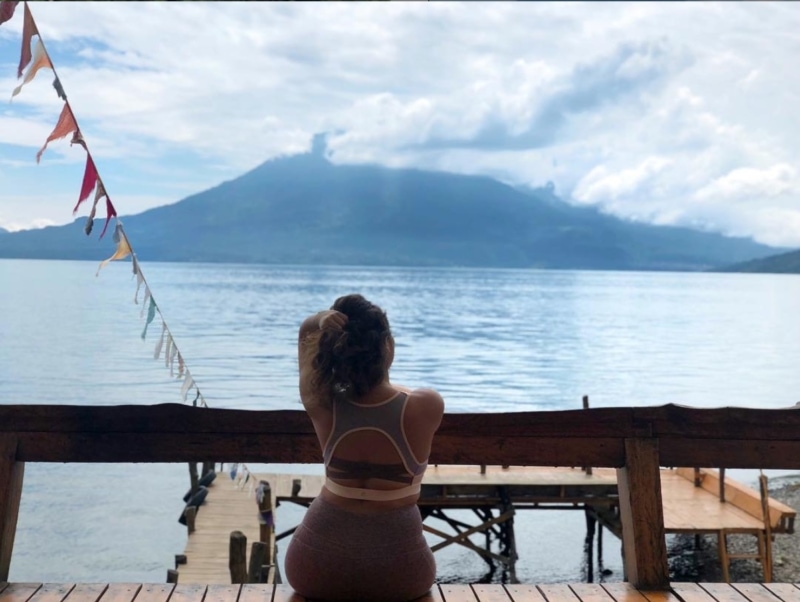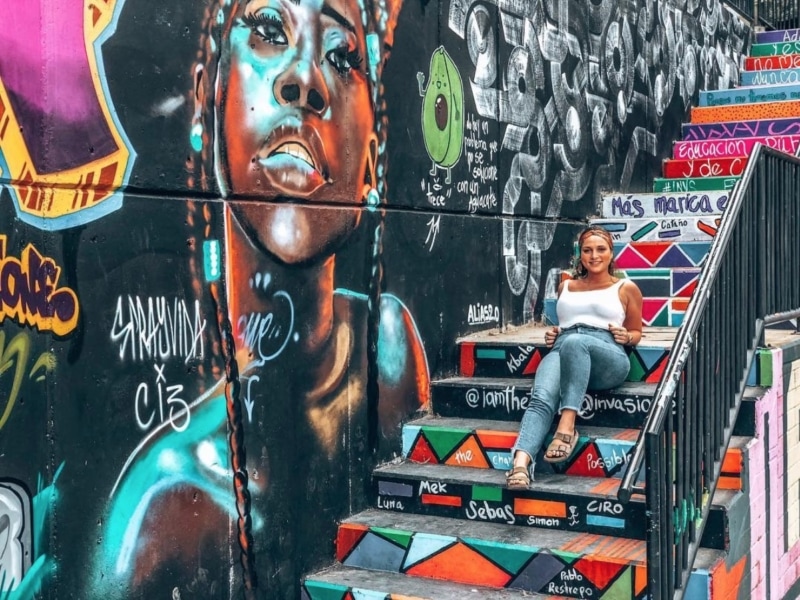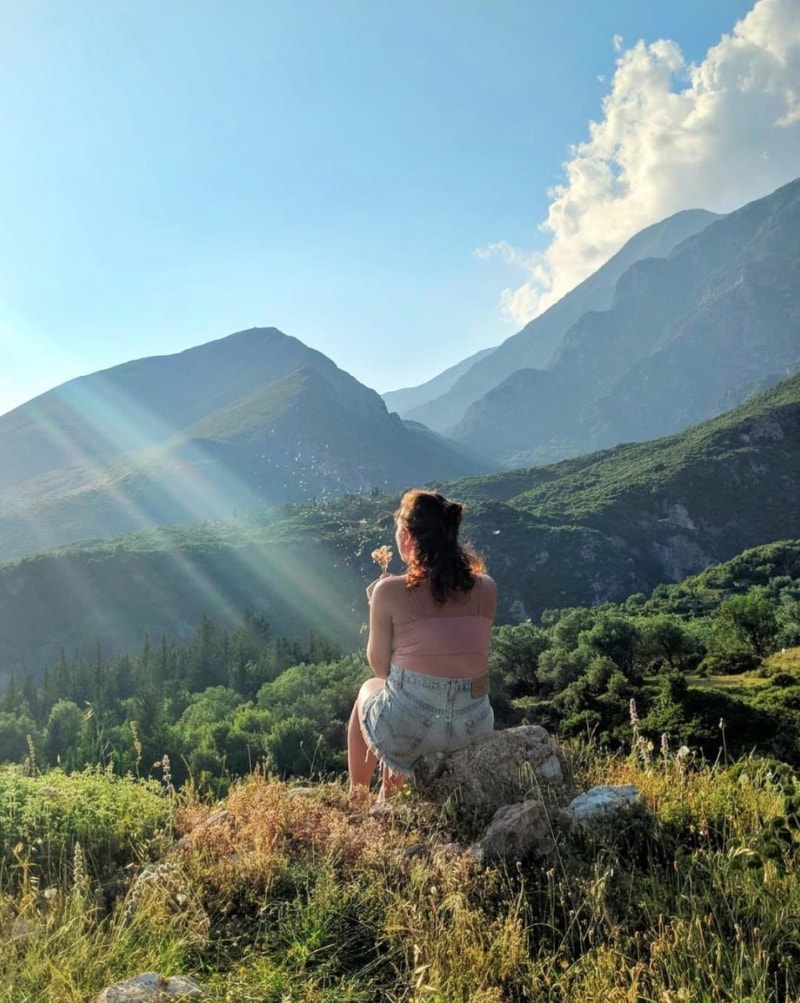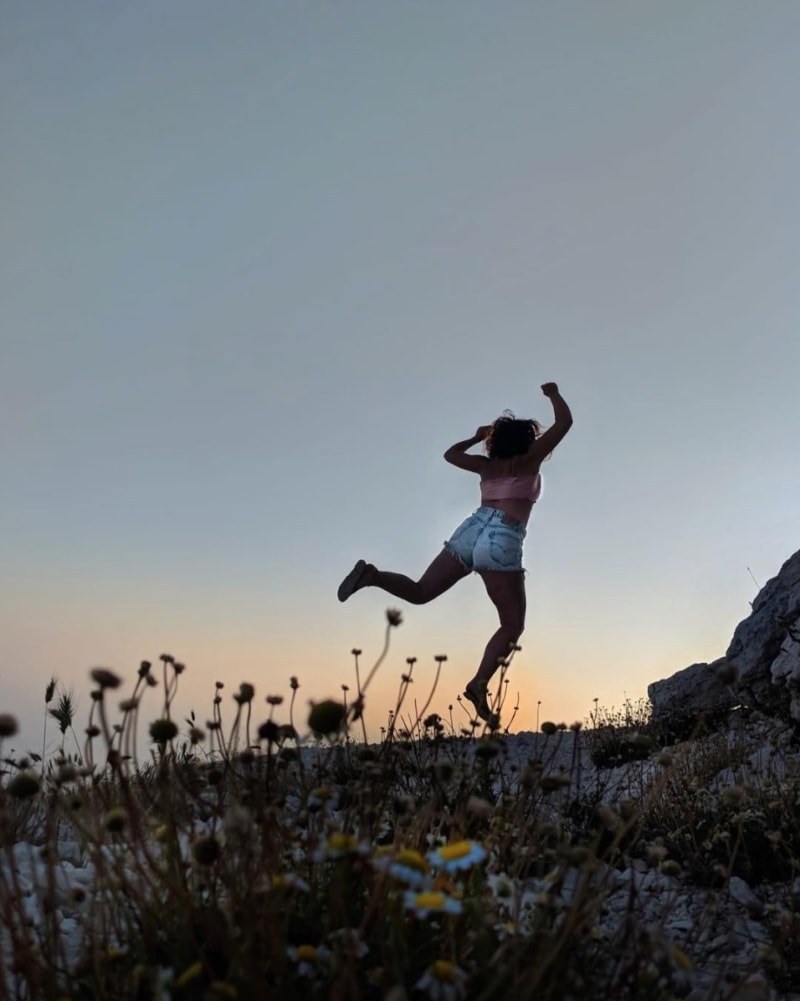A volcanic horizon lines the sky on either side of this dusty dirt road, spluttering lava into the clouds with every thunderous rumble. I’m about four hours into my 12 (ish)-hour bus journey east across Guatemala, snacking on some stale strawberry wafers I bought in a virtually vacant gas station.
I’m en route to Semuc Champey, a natural limestone bridge under which the Cahabón River passes, dramatically cascading into stepped pools that paint the jungle a turquoise blue.
I’ve spent the last few weeks trekking volcanoes outside the colorful colonial city of Antigua and meditating in the mountains encircling Lake Atitlan, an imploded volcano touted today as a spiritual energy field.

It’s been a beautiful journey. A journey that, of course, began with relentless reminders of the number of armed robberies that occur on bus journeys like this one, often by machete. Those close to me made sure I knew that the Guatemalan National Police received over 12,000 reports of property crime, including approximately 1,200 reports of “theft and assault” in 2017.
Perhaps that coupled with the fact that there were approximately 4,400 homicides, 5,200 aggravated assaults and over 2,900 missing persons reported in 2017 is why the U.S. government ranks Guatemala a level three—with the advisory warning to “reconsider travel.”
But, really, my far more pressing concern lies with whoever is farting up a storm on this bus—they love their beans in these parts.
That, and the fact that we could fly off this craggy cliff at any given moment.

The fact is, bad things can happen anywhere to anyone. But women have been conditioned to feel fear in a debilitating sort of way. And, in an age of endemic terrorist attacks, insurgency and a spate of pandemic diseases, solo travel is seldom advised.
For women, fear is only exacerbated by the objectification of our bodies as weapons of war, global gendercide, sex trafficking and more. Women are left to grapple with the thralldom of “what if”— what if something bad does happen if we travel alone?
This is not to negate or invalidate women’s very real experiences with targeted crime or assault while traveling.
We can only focus on what we can control.
1. Always Be One Step Ahead
Planning ahead means a few things. Before I left for this trip, I looked up exactly where the United States’ embassies and consulates are located. In the event of an emergency, I knew where to go or what number to contact for help.
I first learned to jot down embassy information when I almost got stuck in India last year. I’d run out of passport pages and had to pay a visit to the embassy to retrieve an emergency temporary passport. Then upon leaving the country, I needed the embassy’s help again because the airline questioned the validity of my emergency passport.
As it turns out, passports made in India with photos taken in an old woman’s backyard and Photoshopped onto a white background don’t look too legit.
At the time, I was scared I’d be stuck in India with no way out. Fortunately, I haven’t had to visit the embassy for any actual danger. But I feel a lot more comfortable traveling now that I know where to turn.
The embassy will also be able to help you find adequate aid services, schedule transportation back home or report crimes.
If you feel unsafe before anything actually even happens—perhaps you’ve found yourself a stalker or you’ve received threats—you can head to the embassy, too. They’ll be able to provide you with more information on the region.
They may also help keep an eye of you, or investigate any leads if it comes to that.

A copy of your passport will be helpful if you lose yours or, worse, if you’re robbed. That’s because you’ll need to prove your identity and citizenship to the U.S. government (if you’re American).
You’ll still have to visit the embassy, answer a ton of questions, call friends and family back home to vouch for you and complete a ton of paperwork. But if you have a copy, it’ll save you a ton of time.
You should always have copies of your identification. Laminated copies are better so they don’t get damaged.
You might also want to let someone back home know any preliminary plans. If, for example, you’ve booked flights and accommodations, send that flight information to a friend or family member.
That said, if you have no idea where you’re sleeping at night or where you’ll end up in a few day’s time (you’re doing it right), let others know as you decide. The point is to make sure someone at home knows your general whereabouts. In the event of an emergency, they’ll have a better idea of where to find you. This could accelerate getting you any help you might need.
2. Surround Yourself With Other Travelers
Put yourself out there by really immersing yourself in the traveler community. One way to do this is by staying in social places, such as hostels. Doing this will ensure that you’re never really alone, even though you’re technically traveling solo.
If a dorm room isn’t necessarily appealing to you, you can still opt for a private room in hostels that still boast social atmospheres.
You’ll meet other travelers on the same route as you or interested in heading to the same places. Using the buddy system is smart while traveling—especially on long bus journeys or when you’re taking local transportation that can be quite confusing to figure out on one’s own.
One of my most memorable experiences traveling with other backpackers took place in Sri Lanka. I was aboard the “most scenic train ride in the world” from Kandy to Ella. We journeyed through rolling rice fields and tea plantations, sprawling mountains, buffalo-peppered farms and indigenous villages.

Unfortunately, the train broke down beside a malodorous sewage plant, and those of us packed inside got to know each other very well…for nine hours.
There weren’t enough seats for all of us, so I was already sweating on a stranger’s lap. But she and I, and two others we’d met inside, ended up traveling together for weeks thereafter. We were all headed in the same direction, so splitting travel and hotel costs made sense.
And, of course, it’s nice to have a beer with someone other than yourself sometimes.
I enjoyed Sri Lanka that much more because I felt safer taking public transportation and walking around at night with friends.
We were all in it together.
If you don’t meet other travelers who are headed in the same direction, you’ll likely meet others who’ve been to or have come from where you’re going. You can ask them for any travel tips they might have that locals might overlook.
3. Immerse Yourself by Doing as the Locals Do
As a traveler, you don’t want to stand out so much. Doing so makes you an easier target. There’s a common conception around the world that travelers, particularly in underdeveloped parts of the world, are likely wealthier; so locals might assume you’re carrying valuables on you. The more you immerse yourself in the culture, the easier a time you’ll have.
For example, the more you dress the part, the more comfortable and safe you’ll feel.
And if you’re walking around with your shoulders exposed in a country where women cover their shoulders, for example, the likelihood of you facing unwanted sexual attention is much higher. That doesn’t make it even remotely acceptable, but it does, unfortunately, make it probable.
Wear what will make you feel comfortable, bearing in mind local norms.
DISCLAIMER: It’s never okay to tell a woman what to wear—or that what she wears warrants harassment or assault. But some underdeveloped (and even developed) countries will not respect that.
On top of wearing what locals wear, you can go where the locals go. After all, part of traveling fearlessly is knowing where you’re going and how you’re getting there. Of course, that’s a rarity on the road. But if you look lost, you’ll be a more vulnerable target.
Chances are that you won’t have WiFi all the time to Google where you’re going. So download your Google Maps ahead of time for offline use. Even if you’re navigating as you go, you’ll have a better lay of the land.
And for those times you find yourself hitchhiking in the back of a pickup truck, you can follow the map to at least ensure they’re taking you in the right direction.
You can also engage in the community by enrolling in regular classes there (language, cooking, dance, etc.) or partaking in weekly events like Monday night trivia at the local watering hole.
Just be sure to stay away from certain areas of cities where organized crime is more common. For example, there are zones in Guatemala City notorious for gang violence. That’s why I’m heading for the jungles outside of the city.

4. Use Your Brain (Duh)
Use your brain when it comes to traveling. It’s obviously safer to travel during the daytime, and some routes or methods may be obviously safer choices.
Traveling during daytime is always preferable, even if it does eat a day of your trip. If you’re booking flights, for example, aim to arrive before nightfall. The airport and roads to wherever you’re going will be busier and, thus, safer in the day.
And it’ll just be easier to navigate when you can see what’s going on around you.
If you do have to take an overnight bus, which can save you time and money, follow these tips:
- Buddy up. Ask around if any other travelers in your area are heading in the same direction and bus it together. I’ve done this plenty of times with other women I’ve met in hostels. One time, I even swapped beds to sleep more comfortably next to another woman instead of beside the drunk man with whom I was initially paired.
- Take advantage of ridesharing apps. Taxis are often unmarked and drivers can get aggressive trying to rip you off. If you have an option to travel by Uber or other ridesharing apps instead of by local taxis, do it. You’ll feel more comfortable knowing that the car you’re in is being tracked, and the driver has ratings.
- Use apps like Rome2Rio to book travel. Rome2Rio suggests all of the routes to get from Point A to Point B, including transportations options including airlines, shuttles, ferries and more. And because it’s such a popular travel app, you can rest easy knowing that the companies they recommend are vetted and safe.
Maps.me is another app that you can use even when you don’t have WiFi, so long as you’ve downloaded that country’s map (you can download offline maps with Google Maps, too).
Whenever you’re in a taxi or rideshare, follow the map to make sure you’re heading in the right direction and the driver isn’t taking you someplace else.
5. Seek Support from other Women
You’re probably more fearless at home than you are on the road. That’s largely because you’ve got familiar faces around every corner, and every barista in town knows you by name (and your coffee order).
If you’re traveling alone, you’ll feel more fearless if you surround yourself with other people, particularly women. In my experience, local women (especially older, local women) are willing to help.
For example, if you need help with directions to your place of accommodation, but you don’t feel comfortable letting a strange man know where you’re staying, ask a woman to point you in the right direction. While it’s not guaranteed that you’re safer asking a woman for help, you’re likely safer.

I’ve had wonderful experiences with women helping me along my travels. While living in Rabat, Morocco, I had an entire medina of moms watching out for me. They were always telling me who and what to look out for and, if they saw me walking alone, they’d walk beside me. They all talked, too, so they all knew my business before I even knew my business; but I kind of liked it that way.
To get to know more women in the community personally, consider doing the following:
- Take a local language lesson, or even enroll in a cooking or dance class. Do something fun and engaging.
- Sure you won’t have years of cultivating that homey feel, but you can establish rapport with enough people in the neighborhood. Engage with locals everywhere you go—from the bus stops to the corner stores.
- Exchange numbers with locals who are willing so you have contacts in case of an emergency. All you have to do is ask.
6. Appreciate the Lows and Embrace the Change
When you travel, the lows are really low, and the highs are really high—and you can’t necessarily have the latter without the former. You need to take risks in order to have life-changing experiences traveling.
Part of traveling fearlessly means being able to accept whatever comes your way. That may mean a delayed flight, a dose of bed bugs or a sudden stomach virus from that street meat you knew you shouldn’t have eaten.
I’ve had bed bugs so many times that, when I find cockroach nymphs in my bed, it thrills me. I’ve dealt with stomach bugs (and possible parasites) for weeks with only squat toilets.
Once following a hike, I pulled blood-sucking leeches out of my hair for days.

Another time after wiping out white-water rafting, I found hundreds of black fly larvae in my bloody bathing suit bottoms. Heck, I even bit into a piece of dried fruit in a Thai market and spit out the pit along with my broken tooth.
Somehow, some way, the sun still rises every morning.
If you are faced with a low you didn’t anticipate, appreciate it. The change in your course could be a humbling experience, even if it doesn’t feel like it right away.
7. Keep an Open Mind but Trust Your Gut
Traveling alone means earning your own trust. You’ll often have to be your own pilot and copilot, and make decisions for yourself. This means that, while you should never be too trusting of strangers, you’ll eventually learn to trust your own intuition.
Keep these tips in mind when it comes to trusting your gut:
- If your gut is telling you that a situation seems off, remove yourself from that situation. If a salesperson seems to have questionable motives, don’t buy your tour from them. Shop around.
- Understand that some people who have poor experiences in a place have gone with negative expectations. If you look for the bad, the bad will manifest. When you can find the good in a place and its people, you can follow that good and feel safer for it. Whatever you do, don’t listen to everything you read on the internet about a place. And definitely don’t listen to the people who’ve never been themselves.

8. Hope for the Best, Prepare for the Worst
There are a wealth of ways you can prepare for the worst-case scenario, while keeping optimistic and still hoping for the best.
If you’re traveling long term, traveling with cash will save you money on international and ATM fees. But traveling with cash also makes you a target for thieves.
There are plenty of ways to keep your stuff safe when you travel. For one, you can carry a decoy wallet and stash cash in various places. Your decoy wallet should be the wallet you’re comfortable giving up. It holds just a bit of cash and perhaps even a fake credit card.
And, if someone does indeed bombard your bus wielding a machete, you can fork it over. Hopefully, the whole thing will be over with a lot sooner that way.
Meanwhile, keep your other cash rolled up in various places. I keep mine in my socks, tampon boxes, my bra, my glasses case, etc. If you’re robbed, you’ll have backup cash at least to get yourself to the nearest police station.
You might also want to pack specific items, such as pepper spray (if you’re traveling by ground only). While you can be hopeful you won’t actually need these, at least you know you’ve got them just in case.
Do your research by speaking with other travelers who’ve been there and done that, and use your own excellent judgment.
You’ve gotten this far.
READ MORE:


